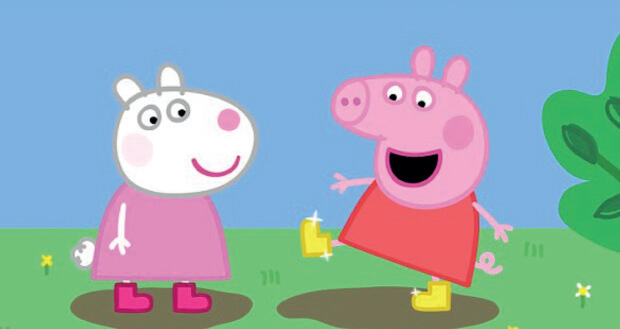Regeneration game
A billion pounds is a lot to pay for a pig. Yet, as ITV and rival bidders have discovered, £1bn is not enough to wrest ownership of TV production company Entertainment One and get their hands on its most prized asset, Peppa Pig.
What makes Peppa, and other toddlers’ characters such as Teletubbies, so valuable is their durability. If the format works for today’s preschoolers, if it excites and stimulates them and meets their developmental needs, it will do the same for tomorrow’s children. At that age, each generation’s needs are identical. That’s why post-millennial kids can bond with Thomas the Tank Engine, despite its creation just after the Second World War.
Think about that. A product that’s sorted for perpetuity. Peppa’s marketers have no need to worry about how to regenerate the brand as its current fans grow to become primary-schoolers and tweens. Let them go. Instead, the customer base, literally, regenerates itself.
If the concept of customer, rather than brand, regeneration is easy to grasp at the front end of life, marketers are willfully blind to its possible application at the other.
Talk to marketers who have an ageing customer base and they will tell a familiar tale of woe. “Our most loyal consumers are dying off,” they will say, concluding that “we need to revitalise the brand to appeal to a younger target group”.
Let them die. There will be another similar cohort right behind them. Why not hold the brand right where it is, nicely meeting the needs of the over-70s, and let nature do the rest? Why not do a Peppa for the old? Well, I have tried asking that and, after the looks of bewildered disbelief that I could venture something so stupid, there comes a whole cascade of reasons why not.
 Chief among them is the view that we should expect discontinuity between one older cohort and the next. How can we be sure the ones coming through will have the same attitudes and desires as those on their way out? The cautionary example is that of the baby boomers, who – so the argument goes – treat this phase of life totally differently from the way old people have done in the past. What if the next lot are even more different? How do we know the brand will be relevant to them?
Chief among them is the view that we should expect discontinuity between one older cohort and the next. How can we be sure the ones coming through will have the same attitudes and desires as those on their way out? The cautionary example is that of the baby boomers, who – so the argument goes – treat this phase of life totally differently from the way old people have done in the past. What if the next lot are even more different? How do we know the brand will be relevant to them?
As so often when there is an ounce of truth, the danger is to draw a pound of conclusions. Yes, there will be differences between one ageing cohort and the next, because they will have lived through different times, but the similarities are likely to be overwhelming. Look more closely at those boomers. At the physiological level they aren’t so different from the group they replaced. Nearly one in five suffers from diabetes, 40% are obese, half take drugs for hypertension, two thirds have some kind of refractive eye issue.
In branding, we talk a lot about attitude but, at this age, in the tussle between attitude and physiology, it’s the latter that tends to prevail. A 70-year-old’s mind might whisper “exotic spice” when considering casual-dining options, but the 70-year-old digestive system will overrule it and it’s off to the carvery again.
As for the boomers’ supposed perpetual attitudinal youth, compare the way they voted on the same issue in 1975 and 2016. Back then they were part of the optimistic, open-minded embrace of Europe; 40 years on, with their fearful rejection, they have turned into their mums and dads.
We give each generation a different, catchy name and, for a while, somewhere between the Peppa Pig days and old age, those cultural and sociological differences exert a force. But once a certain age is reached, the blunt reality of physical needs and the sheer fact of having been alive for so long transcends the more ephemeral influences of zeitgeist and fashion. Convergence rules again: second childhoods are as alike as the first.
So if the brand you manage skews violently up the age scale, don’t panic. Don’t chase the age group below, for whom your brand may be no more relevant than Peppa is for teenagers. Hold your nerve, keep the brand steady and let life’s carousel work in your favour. Your next customers are on it. There are £1bn opportunities at both ends of life.
Silent Generation (born between 1925 and 1942).
They were children during the Great Depression and the Second World War – an austere start in life that shaped them into hard-working, go-getting careerists.
Baby Boomers (born between 1946 and 1964).
Famously optimistic and idealistic. And why shouldn’t they be, given the increases in living standards and great economic advantages they have enjoyed during their lifetime?
Generation X (born between the mid-1960s and early 1980s).
Sometimes known as the “lost generation”, being overshadowed by their more attention-grabbing predecessors and successors. To add further insult, they have been labelled pessimistic slackers, who question convention and tend towards cynicism.
Millennials (sometimes called Generation Y, born between the early 1980s and 2000).
The first generation whose upbringing has been shaped by the internet and all that comes with it. They are self-starting – but also self-regarding – and often seen as “entitled”.
Generation Z (born since 2000).
The first cohort of true digital natives, this generation wants to change the world.
